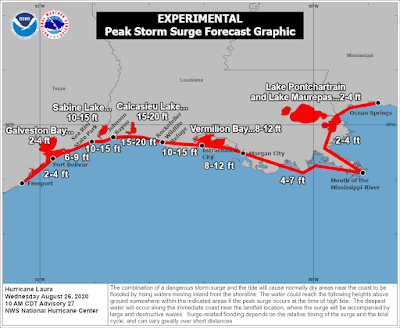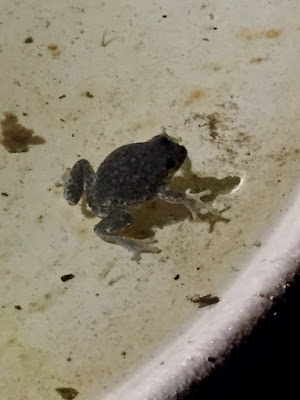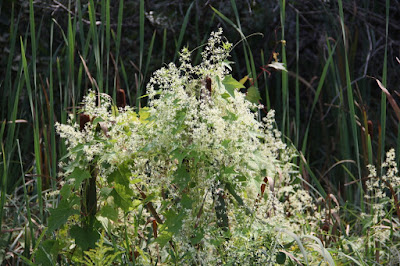Tomorrow ends meteorological Summer. The onset of Autumn brings ripening pears to windfall and whitetail deer to enjoy the bounty. The past few evenings we've enjoyed watching what looks like several whitetail "families," does and fawns (born this year) or yearlings (born last year) checking under the pear tree to see if the "pear fairies" left anything in the grass.
 |
| whitetails under pear tree (October)
Photo by J. Harrington
|
This morning, after the rain had eased, a flock of about half-a-dozen turkey hens made their way through the spotted horsemint and pearly everlasting on the hill behind the house and into the woods to the North of our field. This is the first time in weeks (months?) we've seen turkeys in the neighborhood. We would have been happier if they had had some poults with them.
 |
| spotted horsemint (Monarda punctata)
Photo by J. Harrington
|
I can't begin to tell you how much seeing the deer and the turkeys helps return a sense of normalcy to the world these days. It's going to be a long 64 days until the election and, I fear, that won't bring the insanity to an end, but we live in hope. Maybe the cooler weather will help chill out some of the hot-heads on the political front? (I know, there's a certain pot-kettle element to that question.) I'm going to be watching closely to see what happens during and after tRUMP's planned visit to Kenosha, WI tomorrow.
(To JS/07 M 378
This Marble Monument
Is Erected by the State)He was found by the Bureau of Statistics to be
One against whom there was no official complaint,
And all the reports on his conduct agree
That, in the modern sense of an old-fashioned word, he was a saint,
For in everything he did he served the Greater Community.
Except for the War till the day he retired
He worked in a factory and never got fired,
But satisfied his employers, Fudge Motors Inc.
Yet he wasn't a scab or odd in his views,
For his Union reports that he paid his dues,
(Our report on his Union shows it was sound)
And our Social Psychology workers found
That he was popular with his mates and liked a drink.
The Press are convinced that he bought a paper every day
And that his reactions to advertisements were normal in every way.
Policies taken out in his name prove that he was fully insured,
And his Health-card shows he was once in hospital but left it cured.
Both Producers Research and High-Grade Living declare
He was fully sensible to the advantages of the Instalment Plan
And had everything necessary to the Modern Man,
A phonograph, a radio, a car and a frigidaire.
Our researchers into Public Opinion are content
That he held the proper opinions for the time of year;
When there was peace, he was for peace: when there was war, he went.
He was married and added five children to the population,
Which our Eugenist says was the right number for a parent of his generation.
And our teachers report that he never interfered with their education.
Was he free? Was he happy? The question is absurd:
Had anything been wrong, we should certainly have heard.
********************************************
Thanks for visiting. Come again when you can.
Please be kind to each other while you can.

















